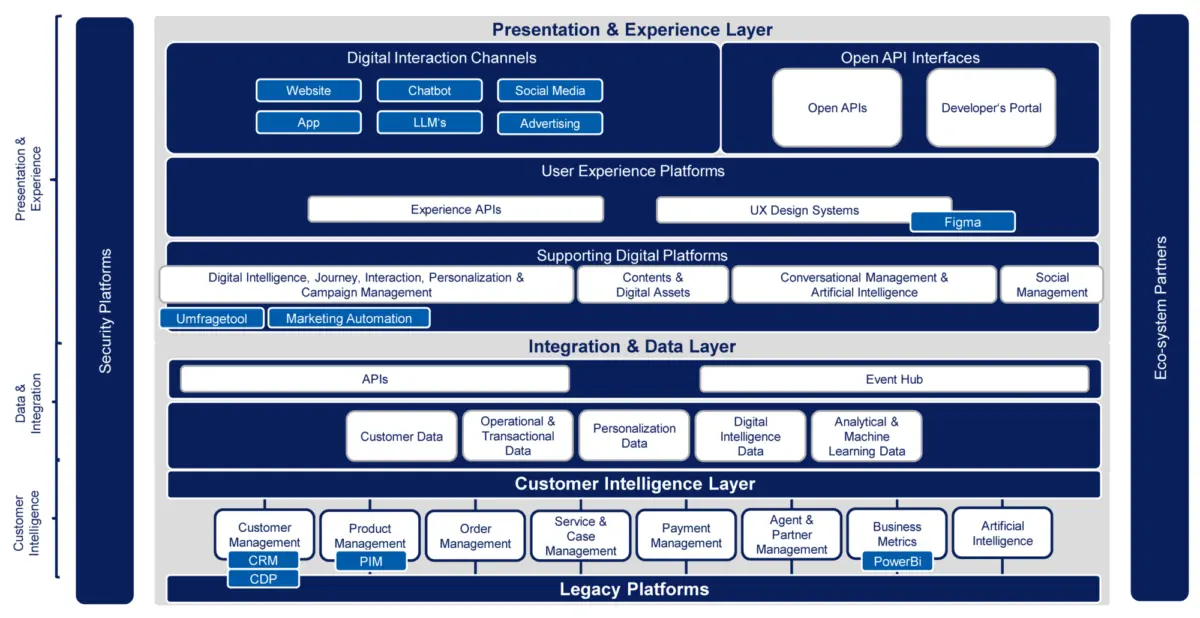From Monolith to Platform
How Modern Digital Experience Architectures Create Competitive Advantages
Highlights, Tech // Lisa Heinz // Aug 18, 2025
Digital Experience Platforms as the Backbone of Modern Enterprise Architectures
Digital Experience Platforms (DXPs) have become a central component of modern enterprise architectures. They enable companies to deliver consistent and seamlessly personalized customer experiences across a variety of channels. Building such a platform follows a multi-layered architectural approach that includes both technical and content components, characterized by flexibility, modularity, and future-proofing.
The User Layer: Consistent Interfaces Through Modern Web Technologies and Design Systems
At the heart of it lies the digital user layer, encompassing all touchpoints with customers or internal users. This includes web and mobile applications as well as portals for partners or service employees. Increasingly, these interfaces are developed using modern web technologies such as React, Angular, or Vue.js. Single Page Applications (SPAs) are employed to ensure particularly high performance and user-friendly interaction.
By using design systems like Material Design, Carbon, or Polaris, a consistent visual language is maintained across all interfaces. These design systems not only define visual guidelines but also provide technical components that development teams can reuse. This significantly facilitates collaboration between design and development teams, reducing time-to-market.
The Integration Layer: API-First and Event-Based Communication for Maximum Flexibility
Beneath the surface, a sophisticated integration layer enables the networking and orchestration of all digital functions. Open APIs make it possible to access individual services and data sources in a flexible and secure way. APIs form the foundation for integrating both internal systems and external partner applications.
A key principle is the strict decoupling of components. Microservices — autonomous, clearly defined functional modules — are increasingly replacing large monolithic systems. These microservices often communicate through events, distributed in real-time by an event hub. This results in highly reactive systems that can respond to customer interactions immediately and in context.
Modernizing Legacy Systems: Strangler Fig and CQRS as a Bridge to the Future
Especially in complex IT landscapes, it is essential to integrate existing legacy systems without compromising the flexibility of modern digital architectures. Patterns such as the Strangler Fig pattern or Command Query Responsibility Segregation (CQRS) are applied here. They allow functions to be modernized gradually, data to be selectively mirrored, and read/write processes to be separated. This preserves the integrity of old systems while enabling a modern user experience.
Added Value Through Personalization and Cross-Channel Experiences
The strategic advantages of such a platform architecture are manifold. Companies can provide customers with cross-channel experiences where interactions flow seamlessly from one channel to another — for example, from a smartphone to a website to a physical touchpoint in-store.
At the same time, the architecture opens new opportunities for personalization through the use of behavioral data and AI-powered analytics. This makes experiences not only more individual but also more emotionally relevant. Furthermore, technological decoupling enables greater scalability, as individual services can be developed and scaled independently.
Technological Independence and Business Benefits Through Modularity
From a business perspective, there are clear benefits: consistent modularization helps avoid vendor lock-in, as components remain interchangeable. Cloud-based infrastructures and platform technologies such as Kubernetes or Docker further support flexible resource management and enable multi-cloud strategies.
The DXP thus becomes the foundation of an agile, customer-focused organization that can not only react to market changes but also proactively drive innovation.

Success Factor: Collaboration — The DXP as a Company-Wide Transformation Task
Building a DXP is not a short-term project but a strategic endeavor that connects technological modernization with business transformation. It requires close collaboration between IT, marketing, product management, and customer service. Ultimately, a well-designed DXP not only improves the customer experience but also creates the foundation for sustainable business success in the digital age.
Start Now: Your Path to a Digital Experience Platform Begins Here
If you want to learn more about how your company can benefit from a future-oriented Digital Experience Platform, we are happy to arrange a personal conversation — let’s shape your digital transformation together.

// Contact
Lisa Heinz
- Head of Digital Experience